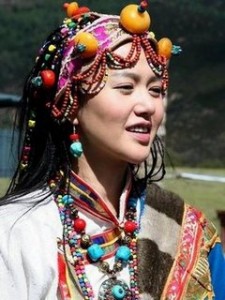Tibetan costumes history. Tang Dynasty Princess Wencheng to Tibet, the Tibetan people brought advanced textile technology and a variety of apparel fabrics Central Plains, the hole in the Potala Palace Zao statue Gampo and Princess Wencheng who can witness the then satin toga costumes, scarves wrapped head statue, with half damask cloak. Yuan Dynasty, Tibetan clothing began to have Cullen wear, just beads heap just shorts. Ming Dynasty, Tibetan Pulu has become Beijing’s main articles of tribute. Time to the Qing Dynasty, the emperor to bestow flowers Ling Tibetan nobles Dingdai officials, and later, it has become a local government of Tibet is the most prominent kind of clothing, and that the level of dress is also very obvious. As social change and economic development, the level of Tibetan costumes boundaries had disappeared. Lhasa Tibetan costumes now only retains a large number of traditional cultural elements, there are many modern colors.

Tibetan costumes feature
Tibetan costumes from the region is divided into two kinds of agricultural areas and pastoral costumes. Tibetan costumes has the following characteristics: fat waist, long sleeves, dajin, right Ren, dress, boots, to Pulu and fur garments, Tibetan men and women head, hands, chest, waist like to wear with a jewelry, gold , silver, copper, jade, ivory and other beautifully crafted jewelry.
Men usually wear black and white farming areas Pulu or serge robe, gowns with sleeves winter, summer sleeveless gowns, underwear wear white shirt sleeve, external beam colored cloth or silk waistband; agricultural area woman robe with the materials specifications Men similar Choushan colored lining, waist line a magnificent pattern “Bangdian.” Labor, they often expose the right shoulder, or bare arms and the sleeves tied around his waist to facilitate activities. Sleep Kuanshu belt, laying half cover half of weatherization.
Pastoral many men do not wear Duangua, wearing no sheepskin cloth robes, dajin, cuffs, bottom, etc. are lined with velvet or wool, outer waist belt; men wear trousers, women wear skirts style Pipao, leather gown with “aprons” materials and red, blue, green, it inserts broadside, elegant, the “Zomba shoes” and “Galuo shoes.” To meet the nomadic nomadic, pastoral dress chest also left a prominent gap, which can be stored for food when they go out or even put young children.
With the development of tourism in Lhasa, Lhasa Tibetan costumes first to show the world the charm of Tibetan costumes. Lhasa Tibetan women dress has an innate appreciation, so here whether women or men, are very particular about the color, but never stuffing, amplified generous grace.
Cangpao
Lhasa women, summer wear Pulu, wool or silk materials song Bapu Mai (sleeveless robe), pay attention to the dark, while the shirt is choose more colorful, bright colors, sleeves palms grow about half a meter, put After touchdown color sleeve down to dancing. Waist with a ribbon fastened to the foot hem robe, as Bangdian, they advocate simple, elegant, there will be some in the top Qunjiao bright gold and silver brocade decoration, but also gave twelve Gesang. In winter, women wear long-sleeved long body robe, if it is sleeveless robe, then set a top coat or Pulu thick woven wool sweater, very harmonious and beautiful.
Lhasa Tibetan woman hair style: unmarried woman knitting a big braids hanging on behind, married compiled double braid, Bianshao compiled into a variety of colored embroidered silk tie forged, do not have charm. They weekdays, hair, pectoral ornaments and hand are relatively simple, only at festivals, the head was wearing a coral and turquoise beads inlaid bar. Tsering winter wear something called the four gold Guo Jinhua ear cap.
Lhasa men robe mostly dark blue, dark brown, dark blue, smoke color-based, using better quality of Pulu or colored wool production, with a ribbon fastened around his waist, the hem edge of the knee hang naturally. Shirt high collar, long sleeves, sub-breasted, dajin two kinds, the use of silk, cotton, silk, cotton, sewing, harmonious colors with matching robe, color, mostly light-colored and gray. Tibetan man behind the generally fine-edged knife hanging, which is decorated in traditional Tibetan men an integral part. Lhasa men also left ear with earrings, decorated with small turquoise ear custom, many people are wearing ivory or jade hand pull that child. Lhasa men wearing woolen hat in summer and more in winter, wearing a fur hat Golden. Feet usually wear Zomba, that is, a Pulu boots.
For thousands of years, summer wear blankets, winter wear fur clothing culture in Tibet, with its rugged, elegant, gorgeous costumes and become human culture in the most research value and appreciate the value of cultural phenomena. As an open and ethnic blend of 20th century, the early 90s, fashion set off a wave of popular Tibetan costumes hot. Cloth is great variety available in the market, there has been stitched belt women’s robe, this robe is both convenient and beautiful, as long as the tie belt, skirt natural shape. Men’s designer robe were cut in half, more appropriate dress, but the overall effect is still a Tibetan robe looks like.
